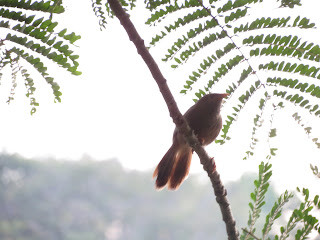Back in 2011, I blogged about trying and failing to spot a vagrant northern shoveler at the Western Treatment Plant. I said I would try again, but the bird flew off too quickly and before I could organise another trip. Well, this year, another shoveler showed up at the Treatment Plant. It was Sunday, we weren't going to do anything, the morning was free, so we all went and tried to spot the shoveler.
At first, I was a bit worried about some Conservation Fires that would be started around Lake Borrie, which is where the shoveler was supposed to be. Unfortunately, by the time we had discovered this we were already at the Treatment Plant. We decided to try birding anyway, but we started out at the Western Lagoons instead. This proved to be a good decision, for it brought me 3 lifers.
As we drove into the lagoons, the calls of golden-headed cisticolas filled the air, as the cisticolas hopped about in the reeds and sang their songs. A black kite flew by overhead, the first of the raptor species we would see that day. We got into the car and drove slowly along Coastal Road. In the second pond of the lagoon, we spotted a flock of banded and white-naped stilts feeding, along with about 8 hoary-headed grebes, before heading on.
A golden-headed cisticola perching on a wire by the side of the road
One of the banded stilts in the flock at the second pond
Soon, we reached another pond, where I spotted hoary-headed and Australasian grebes. At the Treatment Plant, the Australasian grebe is normally seen only in the cleanest of the ponds and is not that common, so I took a photo of the grebe and then we drove on again. It was now that our first lifer showed itself.
An Australasian grebe that was in the pond
My dad quickly stopped the car. I asked him why we had stopped, and he wordlessly pointed to the road. A small flock of finches were feeding on the ground, and I immediately recognised them as my lifer zebra finches!
Most of the birds in the flock were immatures, like the one shown above, but there were also a few adult birds. We chased after the flock as, out at sea, Pacific black ducks and chestnut teals fed with royal spoonbills. Finally, it started to rain and we gave up, deciding to head back home. We drove out of the lagoons, just as it thankfully stopped raining. While getting out of the car to shut the gate, I saw a small bird hop into a pool of water near some reeds. Thinking it might be a crake, I slowly and quietly approached the bird. It darted away swiftly, but not swiftly enough for me not to identify it. It was my second lifer, a little grassbird!
My lifer little grassbird, hopping on a clump of grass
We decided to head back up the road. There were several brown falcons perched on posts. Most of them were the commoner light form, though some of them were dark form birds.
A dark form brown falcon
A light form brown falcon
Just then, we turned around a corner, and there, in the grass, was my third lifer . . .
A SPOTTED HARRIER!
It flew up from the grass, looking for prey, but not quickly enough to escape my camera. Three lifers in one day! I hoped I could spot the shoveler and make that four instead of three.
We drove down to Lake Borrie, ignoring the many Willie wagtails that hopped up and down on the fence. Soon, we had reached the lake. We saw many birders watching for something down at one part of the lake. We drew up to them. We looked. And there, out in the clear water of Lake Borrie were . . .
2 musk ducks.
We waited a little while and asked the birders if they had seen the shoveler. One of them said "I saw it from the other side of the Lake, but I can't find it now." We stayed for a while, but my father had a meeting to go to, so, to the calls of the black-shouldered kites that were hunting overhead, we left the Treatment Plant.
One day, I will get that bird!
LIST OF SPECIES
1. BLACK SWAN
2. PACIFIC BLACK DUCK
3. CHESTNUT TEAL
4. GREY TEAL
5. MUSK DUCK
6. AUSTRALASIAN GREBE
7. HOARY-HEADED GREBE
8. AUSTRALIAN PELICAN
9. WHITE-FACED HERON
10. ROYAL SPOONBILL
11. AUSTRALIAN BLACK-SHOULDERED KITE
12. SWAMP HARRIER
13. SPOTTED HARRIER
14. BLACK KITE
15. PURPLE SWAMPHEN
16. EURASIAN COOT
17. MASKED LAPWING
18. WHITE-NAPED STILT
19. BANDED STILT
20. SILVER GULL
21. BROWN FALCON
22. GALAH
23. RED WATTLEBIRD (in a tree on the way to the treatment plant)
24. BLACK-FACED CUCKOOSHRIKE
25. WILLIE WAGTAIL
26. LITTLE RAVEN
27. WELCOME SWALLOW
28. LITTLE GRASSBIRD
29. GOLDEN-HEADED CISTICOLA
30. ZEBRA FINCH
LIFERS: 3
NEW BIRDS FOR MY VICTORIA LIST: 4
TARGET BIRD SIGHTINGS: 0
































